

 TUTORIAL: SELF AND SOCIETY
TUTORIAL: SELF AND SOCIETYINTRODUCTION . SELF . SOCIETY . SUBGROUPS . SOCIETY AND SELF .
Communication is one of the most interesting aspects of human life. In the words of Kenneth Boulding:
The speaker has some structure that is perceived in the form of
images in the mind and no doubt coded in some energy and matter structures in
the brain. This structure is translated to structures in the nerves that run
down to the vocal cords, which translate it into air waves, which are partly
matter, partly energy. These air waves hit the eardrum of the listener and are
translated into patterns of nerve impulses, mostly electrical.
These pass into
the brain of the listener and are translated there into images that are
unlikely to be identical to the images in the mind of the speaker but, if the
conversation is successful, will be very similar to them. These images will
produce a change in the structures in the mind of the listener, who then
becomes the speaker, and the whole process is reversed, ending in the mind of
the original speaker, who then may react.
We are so accustomed to conversation
that we take it for granted. Actually, it is a process of almost literally
inconceivable complexity .... - Boulding
The need to question and be answered, the longing for communication, is our human hunger, and it is evident from that moment after birth when the newborn sees and hears the mother for the first time. Feeling her caress, hearing her voice as she makes some welcoming sound, the baby already begins to know who she is. Martha Heyneman describes that first exchange between mother and child as the beginning of the flow of language, a new kind of nourishment. - Ellen Dooling Draper
The fundamental Shannon/Weaver model of communication includes a transmitter who creates and transmits a message and a receiver who notices and interprets the message. At first, it seems that there will be little difficulty in applying this model to two people who are communicating.

However, further thought will demonstrate a need to look more closely at what is meant by the terms "transmitter" and "receiver." In human communication the interaction between these two turns out to be far more complex than was first imagined.
When humans speak, they speak in a language. But we also know from our own experience that this language is not adequate to express every thought that we might have. (Who has not at one time or another said, "I know what I want to say, but I just can't put it into words!") This leads to the imagination of a division between our awareness of ourselves and the speech by which we express this awareness to others.
The study of human communication must consider the process by which inner thoughts, emotions, beliefs and other self-awarenesses are translated into language prior to being spoken.

Similarly, once thoughts have been coded into language, they must be converted into into sounds that others can hear. Humans accomplish this by expelling the air in the lungs through the larynx to make sounds which are modifed via the mouth and tongue to produce speech.
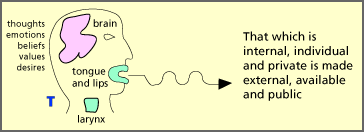
The Shannon/Weaver Model suggests that these translating and converting steps are common to all communication. But unlike non-human transmitters, the human is self-aware. He or she knows "what's on my mind" and often speaks with the intention of making the private, inner world available to others. This notion of intention, or communication for planned effect, is not common to all communicators and is not contained within the Shannon/Weaver Model.
The reception of a human message is similarly complex. Human perceptions are never "turned off" -- the ears, for example, hear every sound that comes within range, whether these sounds are messages or not. In fact, much of what is perceived by the senses must be categorized as noise.
Thus, if humans are to communicate with one another, they must be able to separate an incoming message from the noise that surrounds it. It is not surprising, then, to find that the study of listening is as important as the study of speaking.

Once the sounds of the message have been distinguished from the noise, they must be translated into statements of language. Although this seems as if it might be simply the reverse of the process the transmitter went through in creating the message, it not clear that this is the case. In fact, this process is not well understood.
Finally, as might be expected, the language statements that the receiver's mind has derived from the incoming message must be interpreted or merged into his or her existing thoughts, emotions, beliefs and ideas.
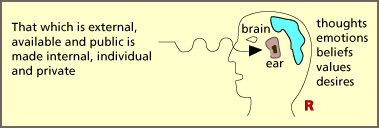
It is clear that acts of speech and hearing use language codes to connect human minds, and although there are many ways of communicating that do not use language, its study provides important insight into the process of human communication.
When viewed in light of the previous discussion, communication between humans would seem to fit the Shannon/Weaver Model quite well. The next picture summarizes the model.
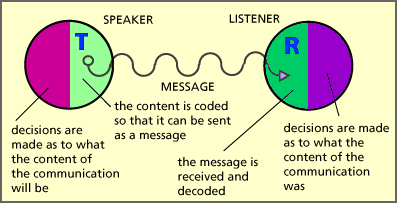
However, observation of actual human communication finds behaviors that do not appear in this model. For example, when people communicate, the receiver often reacts to a message by generating an immediate return message of her or his own. To show this response, often called feedback, it is necessary to extend the model.

Because "feedback" is as much a valid signal as was the original message, the terms "transmitter"
and "receiver" are seen to be quite arbitrary. Both individuals transmit and
receive messages, and they may both be doing this at the same time.

In non-human communication this is interesting but not particularly troublesome. Such communication is relatively simple, and feedback usually represents an expected return message. For example, the typical home heating system uses feedback to control the temperature.
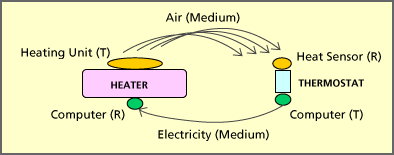
The thermostat monitors the temperature of the air and sends an "on" message if it becomes too cool or an "off" message if it becomes too warm. The heater monitors the electrical channel from the thermostat and turns the heating unit on or off accordingly.
In the last example the number and kinds of
feedback messages were strictly limited. However, because human communication is intentional, the human receiver
is likely to change his or her mind upon the reception of a message. This  means that the feedback message may involve something totally new to the former
transmitter (now the receiver) who consequently may change her or his mind
before responding with even more feedback. As this communication flows back
and forth, it quickly becomes very complicated and difficult to predict.
means that the feedback message may involve something totally new to the former
transmitter (now the receiver) who consequently may change her or his mind
before responding with even more feedback. As this communication flows back
and forth, it quickly becomes very complicated and difficult to predict.
Further observation shows that people tend to gather in groups, that they engage in communication almost constantly within these groups, and that they communicate on many channels simultaneously. This means that a message may involve any of a number of media: sound waves for speech, light waves for gestures or "body language," even particles of "stuff" for smell. Furthermore, people seem to have the ability to "tune out" perceptions that they deem unimportant, and to "tune in" to messages that matter to them.
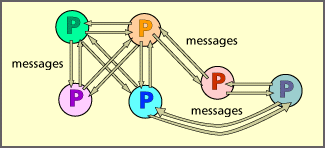
These observations lead to a number of interesting questions that relate to the complexity of human communication - for example:
Questions such as these are part of the research agenda of those who study human communication. Although a full investigation of each question is beyond the scope of this tutorial, many of them will be addressed in greater detail in the sections that follow.
![]() 9504
9504
![]() 9505
9505